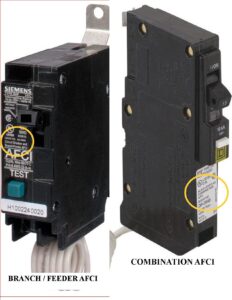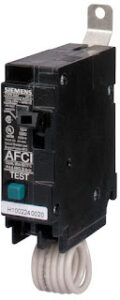ARC Fault Circuit Protection and Home Inspections – PART 2 – Branch Circuit Wiring
ARC Fault Circuit Protection and Home Inspections – PART – 2 Branch Circuit Wiring
Last month we looked at the difference between a Combination and Branch/Feeder AFCI circuit breaker and how to identify and inspect them in the service panel. Now we will look at how AFCI protects branch circuits, how it should be installed and how to inspect the branch circuit. The current requirements consist of 6 options for providing AFCI protection for dwelling units:
1- A Combination AFCI circuit breaker (which provides more protection than a Branch/Feeder AFCI) installed in the electric panel that protects the entire circuit.
2- A Branch/ Feeder type AFCI circuit breaker in the service panel at the origin of the branch circuit with an AFCI receptacle installed at the first outlet box of the branch circuit. The branch circuit wiring must be continuous from the circuit breaker to the first receptacle. The outlet must be marked for easy identification.
3- A listed “supplemental” AFCI circuit breaker installed at the origin of the branch circuit in combination with a AFCI receptacle installed at the first outlet box . Installation is the same as #2 above, except; the maximum length of the branch circuit should not exceed 50 feet for 14 AWG conductors, and 70 feet for 12 AWG conductors, and must be continuous wiring. (Note: Currently a supplemental arc protection device is not available, however it is in the development)
4- A standard over current protection device (circuit breaker) in the electric panel in combination with a AFCI receptacle installed at the first outlet box of the branch circuit may be used. However the branch circuit wiring must be continuous from the breaker to the AFCI receptacle . The maximum length of the branch circuit should not exceed 50 feet for 14 AWG conductors, and 70 feet for 12 AWG conductors. The outlet must be marked for easy identification. The combination of the branch circuit over current protection device and the AFCI receptacle must be identified as meeting the requirements of a “System Combination” type AFCI. This “combination” requires testing and certification to comply with UL–1669. When testing is complete it will be listed as UL-1669C.
5- If steel armored cable joined to metal outlet and junction boxes are used from the electric panel, originating at the proper over current protection device (not an ARCI breaker) and the first outlet in the branch circuit, which contains an outlet branch circuit type AFCI it can provide protection for the entire branch circuit. The AFCI outlet must be marked for easy identification.
6- Using NM or PVC conduit or type MC (metal cable), Rigid Metal Conduit (RMC), Intermediate Metal Conduit IMC, or, Electrical Metallic Tubing EMT which is, continuous and is encased in at least 2 inches of concrete for the portion of the branch circuit between the over current protection device (Breaker) and the first AFCI protected outlet in the circuit is acceptable. The branch circuit conductors will be protected from puncture in this case. The AFCI outlet must be marked for easy identification.
The different installation methods will probably become more evident based on residential, multi-family, and commercial applications. What should a home inspector look for on ARC Fault circuits?
· ARC Fault circuits are only required on 15 and 20 amp circuits
· Using the test button on the installed ARC Fault circuit breaker
· Using the test / reset button on the ARC Fault receptacle
· AFCI receptacles must be readily accessible
· ARC Fault trip receptacle tester. Cost is about $45.00. This tester does not simulate an ARC, it tests the ARC Fault circuit breaker or receptacle for leakage trip function. It will also test for proper wiring of all receptacles except GFCI’s.
· A combination GFCI / AFCI / three prong receptacle testers are available and priced from $79.00 – $159.00.
· More information can be obtained by referencing the NEC – section 201.12
Related Articles:
- GFCI Inspections
- Inspecting Exterior Electrical Components
- Counterfeit Square D Circuit Breakers
- Electrical Sub-Panels – Why Must the Neutrals & Grounds Be Separated
Want To Learn More? Click HERE to Search Our Full Database Of Home Inspector Newsletters.
[/vc_column_text][/vc_column][/vc_row]







